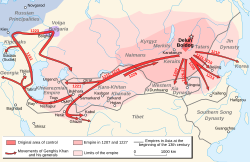Invasi Mongol ke Rus Kiev
Invasi Rus' Kiev oleh Mongol dilancarkan pada abad ke-13. Selama peristiwa ini, bangsa Mongol menghancurkan beberapa kota, termasuk Ryazan, Kolomna, Moscow, Vladimir dan Kiev.[4]
| Invasi Rus' oleh Mongol | |||||||
|---|---|---|---|---|---|---|---|
 Wilayah yang ditaklukan Genghis Khan | |||||||
| |||||||
| Pihak terlibat | |||||||
| Mongol |
Vladimir-Suzdal Smolensk Turov dan Pinsk Rostov Chernigov Ryazan Pereyaslavl Cuman | ||||||
| Tokoh dan pemimpin | |||||||
|
Batu Khan Möngke Khan Subutai Jebe Boroldai Berke Orda Kadan Shiban Güyük Khan |
Mstislav II dari Chernigov † Yuri II dari Vladimir † | ||||||
| Kekuatan | |||||||
|
1236: 35.000 kavaleri Mongol 40.000+ pasukan bantuan Turk[1] 1223: ~20.000 kavaleri |
1236: ~25.000-50.000 total, termasuk garnisun dan anggota suku[2] | ||||||
| Korban | |||||||
| Lebih dari 7.000 | 500.000 (6–7% populasi Rus')[3] | ||||||
Invasi Mongol dimulai dengan meletusnya Pertempuran Sungai Kalka pada Mei 1223. Pertempuran tersebut berhasil dimenangkan oleh bangsa Mongol, tetapi mereka lalu mundur dari wilayah Rus' Kiev. Kemudian Batu Khan melancarkan invasi besar-besaran dari tahun 1237 hingga 1240. Setelah kematian Ögedei Khan, invasi ini dihentikan. Meskipun begitu, semua kepangeranan Rus' dipaksa tunduk kepada Mongol dan menjadi bagian dari wilayah Gerombolan Emas.
Invasi ini mengakibatkan jatuhnya Rus' Kiev pada abad ke-13 dan mengubah sejarah Eropa Timur, termasuk pembagian orang-orang Slavia Timur menjadi tiga, yaitu Rusia, Ukraina dan Belarus,[5] serta kebangkitan Keharyapatihan Moskow.
Catatan kaki
sunting- ^ de Hartog, Genghis Khan: Conqueror of the World, pp. 165–66: notes that contemporary Mongol sources describe Batu as invading with 12-14 tumens, which would give him a nominal total of 120,000-140,000 men. However, the author also notes that tumens were often at less than full strength.
- ^ Fennell, John. "The Crisis of Medieval Russia: 1200-1304." London, 1983. Page 85. Excerpt: "If we assume that each of the larger cities could field, say, between 3,000 and 5,000 men, we can arrive at a total of about 60,000 fighting troops. If we add to this another 40,000 from smaller towns and from the various Turkic allies in the Principality of Kiev, then the total coincides with the 100,000 estimated by S.M. Solov'ev in his History o Russia. But then this is only a rough estimate of the potential number. We have no idea how many, towns and districts actually mustered troops- for instance, it seems highly unlikely that Novgorod sent any at all. Certainly none came to help their outpost at Torzhok. Perhaps then half or a quarter - or even a smaller fraction- of the total was the most the Russians could muster."
- ^ Colin McEvedy, Atlas of World Population History (1978)
- ^ "The Mongol Invasion of Russia in the 13th Century | Study.com". Study.com (dalam bahasa Inggris). Diakses tanggal 2017-05-15.
- ^ Boris Rybakov, Киевская Русь и русские княжества XII-XIII вв. (Kievan Rus' and Russian Princedoms in 12th and 13th Centuries), Moscow: Nauka, 1993. ISBN 5-02-009795-0.
Daftar pustaka
sunting- Allsen, Thomas T. Culture and Conquest in Mongol Eurasia. Cambridge UP.
- Atwood, Christopher P. Encyclopedia of Mongolia and the Mongol Empire (2004)
- Christian, David. A History of Russia, Central Asia and Mongolia Vol. 1: Inner Eurasia from Prehistory to the Mongol Empire (Blackwell, 1998)
- Halperin, Charles J. Russia and the golden horde: the Mongol impact on medieval Russian history (Indiana University Press, 1985)
- Sinor, Denis. "The Mongols in the West." Journal of Asian History (1999): 1-44. in JSTOR
- Vernadsky, George. The Mongols and Russia (Yale University Press, 1953)
- Halperin, Charles J. "George Vernadsky, Eurasianism, the Mongols, and Russia." Slavic Review (1982): 477-493. in JSTOR